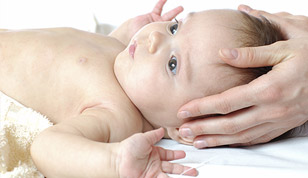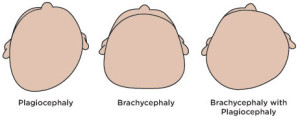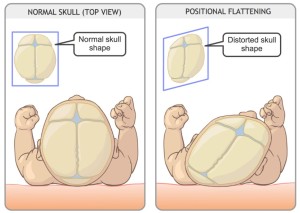Blog Categories
Search Blog
Blog Categories
Flattened Head Syndrome or Positional Plagiocephaly
What is Flattened Head Syndrome/Positional Plagiocephaly?
Flattened head syndrome or positional plagiocephaly refers to flattening of the skull in young babies. This can happen on one side (plagiocephaly), or in the middle, causing the head to look high and ‘cone shaped’ (brachycephaly).
The bones of the skull fuse together at approximately 12 months of age. Prior to this, the bones in baby’s head are soft and flexible. If a child prefers to look in one direction, either due to preference or torticollis, this can cause the head to become misshapen and flat on one side. In more moderate to severe cases, plagiocephaly can cause facial changes; the position of the ears may become misaligned, a bulging of the forehead may be seen, and eye shape can become asymmetrical.
Can Plagiocephaly Affect Brain Development?
This is often a question that parents have. The answer is no. Positional plagiocephaly is purely a cosmetic concern. There is no evidence to suggest that plagiocephaly can affect the developing brain.
My Baby’s Head is Flat. What Can I Do?
- Lots of tummy time. This helps to keep the baby off of the flat spot and develop the muscles required for rolling and sitting up.
- Wear the baby in a carrier during the day, instead of using a stroller, when able.
- Limit time spent in bouncy chairs, swings, car seats, etc.
- Rotate the baby in the crib so he/she is not always looking in the same direction.
- Ask your health care professional to check for torticollis and see a physiotherapist early to treat it if it arises.
- In moderate to severe cases, a helmet can be prescribed at approximately 6 months of age to help correct head shape. These are worn approximately 23 hours a day and are extremely successful at correcting positional plagiocephaly. If your child is between 4-6 months of age, and you are concerned that your child’s head shape is worsening or not starting to improve, ask if a referral to orthotist is recommended.
References
Luxford, B.K., Hale, L., & Piggot, J. (2009). The physiotherapy management of infants with congenital muscular torticollis: A survey of current practice in New Zealand. New Zealand Journal of Physiotherapy, 37 (3).
Robertson, R. (2011). Supine infant positioning – Yes ,but there’s more to it. The Journal of Family Practice, 60 (10), pp. 605-8.
Van Vlimmeren, L.A., Helders, P.J.M., Adrichem N.A., & Engelbert, R.H.H. (2006). Torticollis and plagiocephaly in infancy: Therapeutic strategies. Pediatric Rehabilitation, 9 (1), pp. 40-46.








